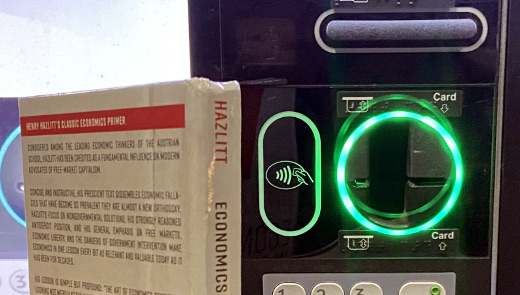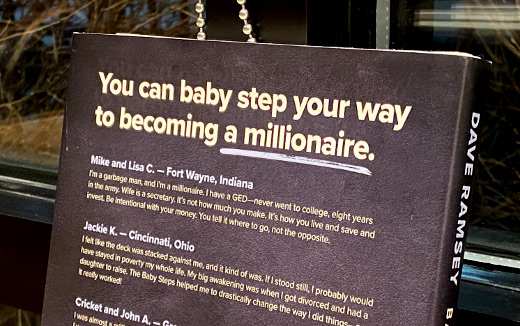My Takeaways From Economics In One Lesson

Economics. When you hear that word, what do you think? For some, it's a view of the world and how it operates. For others, they simply ignore it. For myself, as aware as I like to be of what happens in and around me, the topics of economics was always a fragmented one.
Taking Economics 101 in college didn't help things. It may have been a combination of things, including the nickname for my professor being "shaky" which was related to his hand gestures, how much alcohol he reportedly drank and likely both. The constantly exploding red pens in his shirt pockets was another distraction. I will never forget when he typed tests on a manual typewriter, he simply backspaced and put a slash thru mistakes and kept typing. Though these are no excuses, all my memories from that class are non-academic.
When I learned about a book called Economics in One Lesson by Henry Hazlitt, I had to check it out. Both being "one" lesson and being free were enticing to me. The book was offered by the Mises Institute, a libertarian think tank, and I took them up on their offer to receive a printed copy of the book, an offer unfortunately is no longer available. Hazlitt, a libertarian author, originally wrote the book in 1946 and it was revised and extended in 1979. As libertarians (and I am grossly summarizing here) believe in very small government and free markets, I was interested in what I learn from the text, as some of my own world views are in line with this thinking.
As I read through the pages of Economics in One Lesson, it helped me structure the bits and pieces of economics I have collected over the years, and I had several takeaways from it.
Simple examples – To setup what I was about to learn, in the early pages of the book was a hypothetical story of a store keeper who was saving for a new suit but had to spend the money on a new window when one in his shop was broken. As a result there was no net benefit to economy – the window glazer made out but the tailor did not, and neither did the store keeper for that matter. Stories like this and others help set the stage and drive home concepts throughout the book.
Global view – Hazlitt states that to truly study an economic impact you must trace both short and long term impacts and impacts on a special group and everyone impacted by it. He gave examples of laws and decisions made by governments that benefit one group at the expense of another, and that impact may be long after the decision is made and executed upon.
So what is Credit? – A statement that stuck out to me is regarding credit, that is something we already have not something a lender gives us. Granted if I walked into any bank and said that they would laugh at me and want to see my FICO score, but it is something I recall whenever the topic of credit comes up.
Economic Sybil – The idea that we have multiple economic personalities was something I hadn’t thought about. Some of those include being a producer, taxpayer and consumer, and the thinking around each will have some common and uncommon components.
Economics in One Lesson was an enjoyable read, something I wasn’t expecting for a book on this topic. It was written in a way to educate without shaming and didn’t pretend to be the one and only book you should read on economics, as in the end there were suggestions for further study. Where the offer to get this book for free no longer exists, I recommend picking up a copy if you are interested in learning or brushing up on economics. For the giveaway of this book, it is going to stay in the house for now as my lovely wife is interested in brushing up on what she learned here and abroad in economics.
This is from The Hot Iron, a journal on business and technology by Mike Maddaloni.
Did you enjoy this? Subscribe to The Hot Iron by RSS/XML feed or Read by Email
Book Take-Aways • (0) Comments • PermalinkShutterfly Serendipity and Solicitude

Back in November 2022 I got an email from photo products company Shutterfly that starting in the new year customers were required to place orders every 18 months in order to store photos on their platform. Not knowing what I had stored with the service, I logged in found a couple of dozen photos from over the years. I downloaded them and then deleted my long-inactive account.
In the process of doing so, I found I had another Shutterfly account, one tied to an email address I wasn’t even using anymore. Upon dusting off that email and logging into that account, I found I had a few more images stored there – 3,283 to be exact. Yes, over three-thousand images I had clearly forgotten about. After some intense eyebrow-knitting, I remembered why they were there: in 2011 film processing service PhotoWorks.com shut down and allowed all images stored online to be transferred to Shutterfly, which I apparently did. And there they were for all these years.
What the Film?
Prior to the almost-purely digital age of photography we live in, there were film cameras. In the 1990’s I learned about a company called Seattle FilmWorks, where you could mail in your film for processing and get back paper prints, your negatives and a floppy disk with digital images of your photos. This was a game-changer for me, and I became a loyal customer. Over time they rebranded to PhotoWorks.com, and eventually shut down. But by that time, I was already using a digital camera and eventually my mobile device for photography.
The digital images provided by Seattle FilmWorks were in a proprietary format that could only be viewed and extracted into a non-proprietary format with software they provided. Over time I did this for many of the images, but not all, and I still have the digital files archived from those original floppy disks. That being said, the resolution of the original images was rather small; on average an image was only 768 x 512 pixels, where today an average image from my iPhone is at least 5 times that size.
Nonetheless I downloaded all of the images from Shutterfly and deleted that second account. As one my guess, the process of downloading over 3,000 of anything is a workload, and this was no different. On top of it, all of the images were in one giant folder and not organized by their corresponding roll of film as they likely were at PhotoWorks. For backup purposes I wanted them all, though eventually I will likely digitize the negatives to more modern dimensions. The accompanying picture with this post is one of those pictures – taken years ago along the trail between Lexington and Concord, Massachusetts where my then-girlfriend (now wife) and I came by a couple of American Revolution re-enactors. Our pleas to them to not shoot us didn’t humor them, but they did pose for this picture.
Where the fancy word for concern comes in
As I mentioned, I deleted both accounts with Shutterfly. Nothing personal to them, but I can’t recall a time when I ever ordered from them – there was no order history in either account. If I ever want to in the future, I am sure I can create a new account. This maintenance was part of managing my external digital presence, or footprint as it is often called.
Over time I review the massive list of accounts I have with online services. If it’s a service I use often, I will periodically reset the password. If it’s one I don’t use at all, I will try to delete it – I say try as some services don’t give the option. Sometimes when I try to login to an account, the service is gone altogether, and then I just strike it from my list. This periodic maintenance is necessary, but something I am not as diligent with as I would like to be, not to mention something most people don’t do at all. Where this doesn’t keep me up at night, it is something I am concerned about.
So what else of mine is out there, waiting for me to reclaim it? What else of yours is out there too?
This is from The Hot Iron, a journal on business and technology by Mike Maddaloni.
Did you enjoy this? Subscribe to The Hot Iron by RSS/XML feed or Read by Email
Strategize • Technology • (0) Comments • PermalinkMy Takeaways From Baby Steps Millionaire
Money. The mere mention of the word can evoke all kinds of thoughts and emotions. From joy to concern to comfort to panic to, oh crap, did I pay the electric bill this month?
Most all of us have money in some way, shape or form and the opportunity to do most all we want with it. But could you be a millionaire? I am sure some reading this are, some don’t care, some see no way and maybe some have no idea if they are or not. From game shows to lottery tickets to Austin Powers movies, the milestone of being a millionaire has been one known throughout the world.
But back to the question – could you be a millionaire? Dave Ramsey thinks you can. The long-time radio and TV host of personal finance programming and author has been professing common sense regarding money and finance for decades. Where I have been aware of him and seen and heard his shows on occasion, I have never really dove into what he professes. When I heard of his recent book Baby Steps Millionaire, I was intrigued and picked up a copy.
Baby Steps Millionaire tells the tales of people who became millionaires – they have a net worth of or over one million US dollars and how they achieved it. As I read through the book, a few takeaways formed in my mind.
People and how they did it – Where I am not trying to spoil the book for you if you are equally intrigued to read it, it may not come as a surprise for the majority of them there was no “fast path” and it involved sound spending and investing over time. There are many stories that are somewhat similar in context in how people reigned in spending, cut expenses and made lifestyle choices and saved even when they didn’t think they could. These stories make up the first half of the book, and though after a while they become a little repetitive, Ramsey is merely driving home the point on how you can be a millionaire too.
Survey says – The second half of this book is the results of a survey of millionaires, and builds and heightens the first half with more concrete data. It starts out going into rather detail about how the survey was developed and conducted (maybe all surveys do this, I don’t read many surveys in this kind of detail) and then shows the results of what millionaires say about how they got to where they are. Sure, a few inherited their millions from the infamous long-lost uncle, but many followed the sound money steps that were driven home in the first part of the book to get to where they are.
Off-site storage – Dave Ramsey’s first baby step to financial stability is one I have known for years in setting up an emergency fund with $1,000. If you get into a bind, it’s the thing you break the figurative glass of and tap into, then work to replenish it. Though we have savings accounts of different ilk, my family did not have a specific emergency fund, and now we do. But $1,000? Today?! A small amount comes out of each of my wife and I’s paychecks and goes into the account that is at a bank that isn’t our primary and one we have to make an effort to get to. It’s a good feeling to finally have this.
Baby Steps Millionaire is a good read that I recommend as a friendly reminder of how you can achieve financial goals, whether you want to be a millionaire or not. Where some of it can be repetitive, it is a positive book that shows many examples of how people got onto a financial track and took off. As I give away all books I read, I am giving this one to someone who is getting back on track in many ways, and I hope it gives them inspiration when it comes to the M word.
This is from The Hot Iron, a journal on business and technology by Mike Maddaloni.
Did you enjoy this? Subscribe to The Hot Iron by RSS/XML feed or Read by Email
Book Take-Aways • (0) Comments • PermalinkCelebrating 16 Years Of The Hot Iron Partially with AI

Congratulations to Mike Maddaloni on 16 years of successful blogging at The Hot Iron. It is a notable achievement to consistently produce high-quality content for such a long period of time.
Note that the preceding 2 sentences were not written by me, or any human being for that matter. It was generated by the artificial intelligence (AI) chatbot ChatGPT. Not bad, eh? That being said, it took some effort to generate it and put this post together.
Why AI?
Over the last few months I have been hearing more about ChatGPT and how with a query or feeding of information to it will give a reasonably understandable response. Intrigued by this, I created an account with the platform (note you need to provide an email address and a phone number to verify yourself) and gave it a try. The 2 lines above were generated as a result of the following query:
“Congratulations to Mike Maddaloni in the third person on 16 years of blogging at The Hot Iron in 2 sentences”
The query was tweaked several times, the final one here worked for this piece after I added “in the third person” as previous attempts consistently used the first person, likely as it was trying to “chat” with me rather than generate a statement to be used here. Also in previous tries it added a third statement of “well done!” at the end every time until I added the third person language even though I explicitly stated I wanted only 2 sentences.
Once I was satisfied with the text, I thought why not accompany it with an AI-generated image? After trying several AI art generators I found from search engine queries, I gave up. Trying requests with variations on “number 16” did not give me an image that had the words or numerals in it, so I went outside and took a picture of my house number, brought it into GIMP and messed with its filters to create what is appearing above.
A good first try with AI generated content; good but not great. Will future posts here contain more AI-generated content? Possibly, as I am just beginning to explore this area. If there is, I will certainly disclaim it.
Happy New Year!
This is from The Hot Iron, a journal on business and technology by Mike Maddaloni.
Did you enjoy this? Subscribe to The Hot Iron by RSS/XML feed or Read by Email
Announcements • Technology • (0) Comments • PermalinkMerry Christmas 2022

Merry Christmas to my friends, family, readers and anyone else who happens to read this!
When I was thinking of what photo to accompany my greeting, I could have easily taken one of the blowing snow amidst the subzero temperatures that has consumed the upper Midwest this week, but the scene above caught my eye the other day. This is the façade of the former Hollister store at the local mall that has remained long after the store moved to a more modern-looking space. With the weather outside as frightful as it is, there was something about the faux California beach scene decorated for the holidays that made me smile.
Whether you celebrate the holiday in any way shape or form, or not, may your day be as full of happiness as possible.
This is from The Hot Iron, a journal on business and technology by Mike Maddaloni.
Did you enjoy this? Subscribe to The Hot Iron by RSS/XML feed or Read by Email
Announcements • (0) Comments • Permalink

